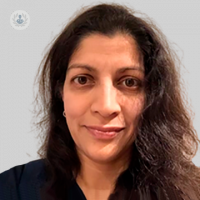Thyroglossal cyst
Dr Natasha Patel - Endocrinology, diabetes & metabolism
Created on: 07-09-2020
Updated on: 01-17-2024
Edited by: Kate Forristal
What is a thyroglossal cyst?
A thyroglossal cyst is a fibrous cyst that can form in the thyroglossal duct. Thyroglossal cysts are irregular lumps that develop from tissues and cells left over after the formation of the thyroid gland during its developmental stages.

Symptoms of a thyroglossal cyst
Thyroglossal duct cysts are often present with a palpable asymptomatic midline neck cyst usually below the level of the hyoid bone. The mass on the neck will move during swallowing or on when you stick out your tongue because of its attached to the tongue via the tract of the thyroid descent. Some people with a thyroglossal cyst will have dysphagia or throat pain.
The sinus or persistent duct can promote oral secretions, which can cause cysts to become infected. Up to half of thyroglossal cysts are not diagnosed until adult life. They can lie dormant for many years until they experience cystic dilation.
Infection can sometimes cause the cyst to enlarge at times with periodic recurrences. Spontaneous drainage may also occur. Differential diagnosis are enlarged lymph nodes, ectopic thyroid, dermoid cysts and goiter.
Thyroglossal cysts usually are a midline neck lump (in the region of the hyoid bone) and it is usually smooth, painless, and cystic, though if infected, pain can occur. There may be difficulty breathing, difficulty swallowing, or dyspepsia, especially if the cyst becomes large.
Thyroglossal cyst are commonly located at the midline or slightly off midline, between the hyoid bone and the isthmus of the thyroid or just above the hyoid bone. A thyroglossal cyst can develop anywhere along the thyroglossal duct.
How can thyroglossal cysts be treated?
If your cyst has a viral or bacterial infection, a doctor can prescribe antibiotics to help treat the infection.
Thyroglossal duct surgery
A doctor may be likely to recommend surgery to remove a cyst, especially if it’s causing you to have trouble breathing or swallowing or if it has been infected.
The Sistrunk procedure.
During the Sistrunk procedure, a doctor or surgeon will give the patient general anaesthesia so that you can stay asleep during the whole surgery.
They will remove the cyst tissue from your neck, a small piece from the inside of your thyoid bone (a horseshoe-shaped bone above the Adam’s apple), along with any remaining tissue of the thyroglossal duct.
This surgery takes a few hours. Patients may need to stay in hospital overnight afterwards. They may also need to take time off from work and make sure a friend or family member is available to take them home.
While they're recovering:
- Patients must follow any instructions their doctor gives them to take care of the cut and bandages.
- Patients must go to a follow-up appointment that their doctor schedules for them.
What are the causes of thyroglossal cysts?
Thyroglossal duct cysts are a birth defect. During embryonic development, the thyroid gland forms in the neck canal, known as the thyroglossal duct. Once the thyroid reaches the final position in the neck, the duct normally disappears.
Areas of the duct remain behind in some cases, they leave small pockets, known as cysts. These cyst pockets can eventually fill with mucus and fluid, enlarging when infected resulting in the thyroglossal cyst.
Who can treat thyroglossal cysts?
You may need to consult with an endocrinologist or a thyroid and endocrine surgeon if you would like to have surgery to treat thyroglossal cyst.
